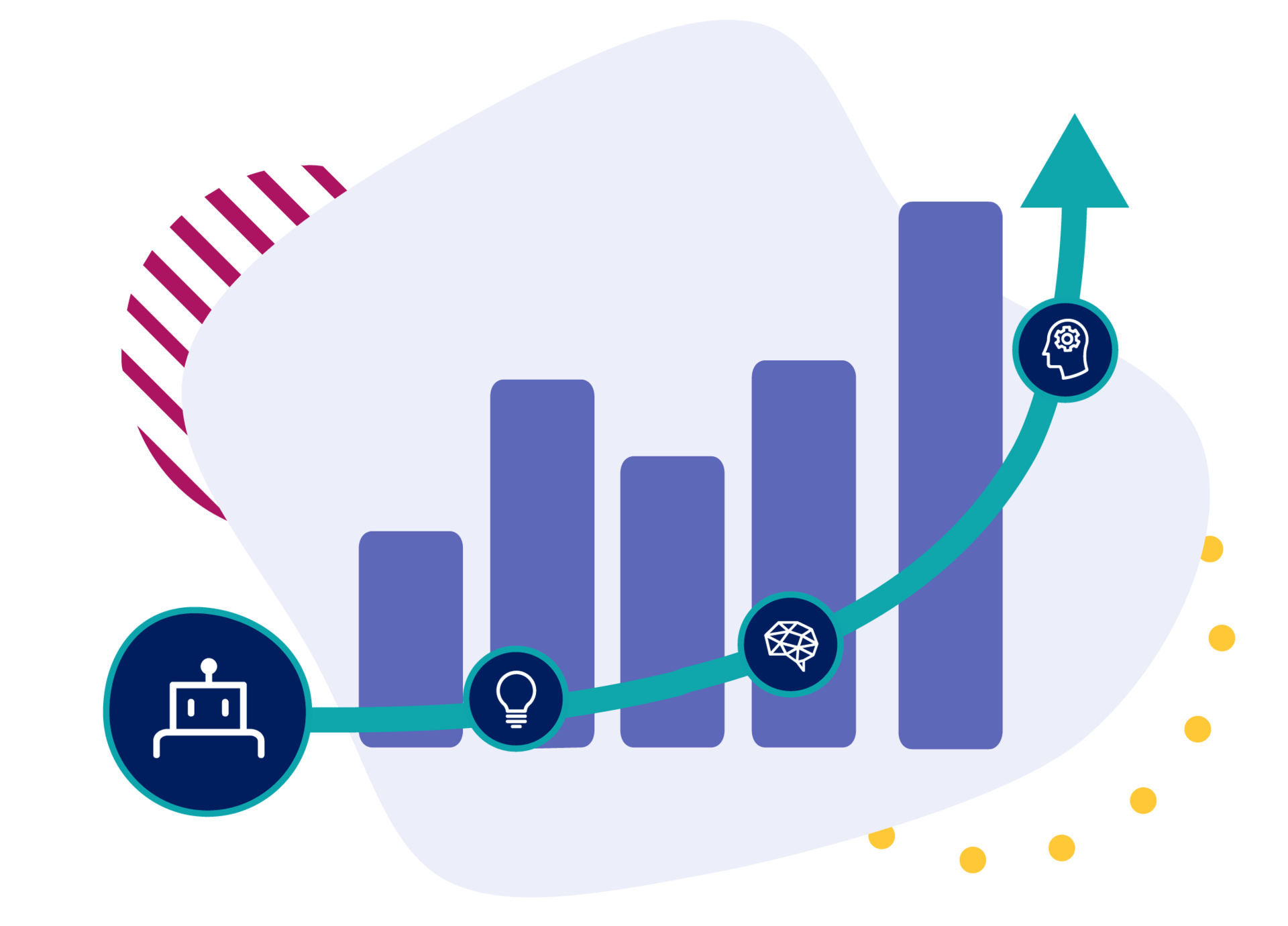Generative KI für Unternehmen
Was ist generative KI?
Generative KI ist eine Form der künstlichen Intelligenz, die Inhalte generiert. Diese reichen von Text, Audio, Videos und Bildern bis hin zu Code und Simulationen.
Die Technologie entwickelt sich stetig weiter und wird daher schon bald in der Lage sein, komplexere Ergebnisse wie persönliche Marketinginhalte, kundenspezifische Anwendungen und sogar Software zu erstellen. Im Unternehmenskontext haben Führungskräfte das Potenzial der generativen KI für die Unterstützung strategischer Geschäftsziele erkannt. Zu wissen, auf welche Verkaufschancen man sich konzentrieren sollte und wie die Einsatzbereiche generativer KI ermittelt werden können, kann jedoch selbst für das technisch versierteste Unternehmen eine Herausforderung darstellen.


Warum ist generative KI für Unternehmen wichtig?
Generative KI automatisierte branchenübergreifend Aufgaben, steigert die Kreativität, verbessert die Effizienz und erzeugt realistische Inhalte. Beispiele hierfür sind – neben vielen anderen – die medizinische Bildgebung im Gesundheitswesen, die Risikobewertung im Finanzwesen, der personalisierte Einkauf im Handel und die Qualitätskontrolle in der Fertigung.
Vorteile der generativen KI
- Automatisierung von Routineaufgaben: KI-gestützte Workflows ersparen doppelte Arbeit, sodass sich Mitarbeitende auf das Wesentliche konzentrieren können.
- Erzeugung personalisierter Inhalte: Die Verbraucher wünschen sich personalisierte Mitteilungen, die ihren individuellen Bedürfnissen entsprechen. Eine kürzlich von Savanta durchgeführte Umfrage ergab tatsächlich, dass eine signifikante Mehrheit (61 %) der Befragten generative KI in erster Linie zur Erstellung von Inhalten einsetzt.
- Zusammenfassung umfangreicher Dokumente: Mit der schnellen und einfachen Auswertung des Ausgangsmaterials kommen Sie direkt zum Kern der Sache.
- Informationen für Mitarbeitende: Bieten Sie intelligente Wege zu Informationen, Prozessen und Richtlinien an, damit alle auf dem Laufenden bleiben und die Vorschriften einhalten.
- Verbesserung der Unternehmens-KI: Die generative KI fungiert als Quelle und Antrieb für Unternehmens-KI, indem sie die Daten und den kreativen Funken bereitstellt, mit dem Unternehmens-KI-Systeme trainiert, verbessert und weiterentwickelt werden können.

Wie funktioniert generative KI?
Anders als beim maschinellen Lernen, bei dem Algorithmen zur Erkennung von Datenmustern trainiert werden, um Vorhersagen und Entscheidungen zu treffen, handelt es sich bei der generativen KI um einen Teilbereich der KI. Dieser nutzt Algorithmen, um neue Daten oder Inhalte zu erstellen, die bestehenden Daten ähneln.
In diesem Video erfahren Sie mehr über Pega GenAI™, eine generative KI, mit der Sie Ihre Produktivität und Kreativität über die gesamte Customer Journey hinweg steigern können.

Von der Erstellung von Inhalten bis hin zur Optimierung von Workflows – transformieren Sie Ihr Unternehmen mit leistungsfähiger KI.
Die Unterschiede: Generative KI und Prädiktive KI
Generative KI
- Generative KI erstellt neue Inhalte auf der Grundlage von während des Trainings erlernten Mustern und Kenntnissen.
- Bei generativer KI geht es mehr um Kreativität und die Erzeugung von Inhalten.
- Generative KI benötigt für die Vorhersage keine bestimmten Eingangsdaten und generiert Inhalte von Grund auf neu.
Prädiktive KI
- Prädiktive KI nutzt historische Daten, um Prognosen zu zukünftigen Ereignissen oder Ergebnissen zu erstellen.
- Bei der prädiktiven KI geht es eher darum, fundierte Vorhersagen zu machen und Empfehlungen abzugeben.
- Prädiktive KI stützt sich bei ihren Vorhersagen stark auf Daten aus der Vergangenheit.
Einsatzbereiche der generativen KI für Unternehmen
Handel
Der Handel steht vor der Herausforderung, seinen Kunden in einem zunehmend wettbewerbsintensiven Markt personalisierte Einkaufserlebnisse bieten zu müssen. Durch den Einsatz generativer KI können Einzelhändler große Mengen an Kundendaten wie Kaufhistorie und Kundeninteraktionen analysieren. Dadurch wird ein hyperpersonalisiertes Kundenerlebnis erreicht.
Fertigung
Traditionell müssen Maschinen in Fabriken erst kaputt gehen, bevor sie repariert werden. Die generative KI kann jedoch anhand riesiger Datenmengen Maschinenausfälle akkurat vorhersagen und proaktive Wartungsmaßnahmen ermöglichen. Dies reduziert die Ausfallzeiten, verlängert die Lebensdauer von Anlagen und senkt die Wartungskosten. Die generative KI revolutioniert die Fertigung, indem sie Prozesse durch Datenanalyse und maschinelles Lernen optimiert.
Gesundheitswesen
Die Interpretation medizinischer Bildgebung ist zeitaufwändig und erfordert spezielles Fachwissen. Radiologen sind oft stark ausgelastet, was zu Verzögerungen bei Diagnose und Behandlung führen kann. Mit generativer KI, die anhand von kommentierten medizinischen Bildern trainiert wurde, können Gesundheitsdienstleister die Bildanalyse rationalisieren und so schnellere und genauere Diagnosen stellen.

Risiken im Zusammenhang mit generativer KI für Unternehmen
Obwohl die generative KI großes Potenzial für Transformationen bietet, birgt sie auch Risiken, die Unternehmen berücksichtigen müssen. Die zugrunde liegende Technologie bei Verbraucher- und Unternehmensanwendungen ist zwar ähnlich, die Einsatzbereiche und Erlebnisse sind jedoch unterschiedlich. Laut einer McKinsey-Studie bietet generative KI das größte Potenzial in den Bereichen Kundengeschäft, Marketing, Vertrieb, Softwareentwicklung sowie Forschung und Entwicklung in einem Unternehmenskontext. Da jede Organisation andere Anforderungen an Workflows, Geschäftsprozesse und Datenschutz hat, versteht sich von selbst, dass generative KI-Anwendungen für Verbraucher nicht ausreichen.
Zu den größten Risiken bei der Integration generativer KI im Unternehmen gehören:
- Datenschutz und -sicherheit. Generative KI-Modelle sind auf große Datenmengen angewiesen, um zu funktionieren. Unternehmen müssen unbedingt dafür sorgen, dass die Eingaben und Ausgaben keine sensiblen Informationen wie private Kunden- oder Unternehmensdaten enthalten.
- Beeinflussung und Fairness. Generative KI-Modelle sind nur so gut wie die Daten, mit denen sie trainiert werden. Wenn generative KI-Tools mit verzerrten Daten arbeiten, können auch ihre Ergebnisse verzerrt sein, was zu Diskriminierung und Ungleichheit führen kann.
- Geistiges Eigentum. Generative KI wird häufig mit urheberrechtlich geschütztem Material trainiert, sodass die erstellten Inhalte möglicherweise gegen die Rechte an geistigem Eigentum verstoßen. Es liegt an den Unternehmen sicherzustellen, dass ihre KI-generierte Inhalte keinen Verstoß gegen rechtlich geschützte Werke darstellen.
- Rechenschaftspflicht und Vorschriften. Da die generative KI im Unternehmensumfeld noch relativ neu ist, sind die Gesetze und Vorschriften noch nicht vollständig etabliert. So ist häufig noch unklar, wer für den KI-Output haftet oder wie haftungsrelevante Probleme von vornherein vermieden werden können.
So arbeiten generative KI und agentenbasierte KI zusammen
Die Synergie zwischen generativer Unternehmens-KI und agentenbasierter KI führt zu einem Paradigmenwechsel in der Art und Weise, wie Unternehmen künstliche Intelligenz einsetzen. Generative KI bietet die kreative Fähigkeit, Texte, Codes, Bilder und vieles mehr zu generieren. Agentenbasierte KI stellt Intelligenz bereit, um diese Fähigkeiten autonom zu orchestrieren. So kann agentenbasierte generative KI komplexe geschäftliche Probleme verstehen, sie in umsetzbare Schritte unterteilen, generative Modelle zur Erstellung der erforderlichen Ergebnisse nutzen und ihren Ansatz auf der Grundlage von Feedback und Ergebnissen schrittweise verfeinern. Dank dieser leistungsstarken Kombination können Unternehmen so effizient und flexibel wie noch nie zuvor arbeiten.


Wohin geht die Reise mit der generativen KI für Unternehmen?
Es besteht kaum ein Zweifel daran, dass die generative KI in die Geschäftsprozesse fast aller Unternehmen integriert werden wird. Darüber hinaus berichtet Savanta, dass generative Formen der KI den KI-Markt heute schon beherrschen. Von der Automatisierung von Aufgaben wie der Erstellung von Inhalten und der Vereinfachung der Anwendungsentwicklung bis hin zur Personalisierung von Erlebnissen für jeden Kundentyp – die generative KI hat das Potenzial, die Entwicklung und das Wachstum von Unternehmen dauerhaft zu verändern.
Generative KI wird wahrscheinlich einen wachsenden Wert für große Organisationen in Form von Wissensmanagement bieten. McKinsey schätzt, dass der durchschnittliche Wissensarbeiter bis zu einem Tag pro Woche damit verbringt, in verschiedenen Systemen nach Dokumenten zu suchen und diese zu analysieren. Sogenannte „Retrieval Augmented Generation“-Assistenten (RAGs) können in diesen Bereichen für Effizienz sorgen, indem sie die Leistung der generativen KI mit der Suche kombinieren, um Informationen auf der Grundlage eines Dokumentenkorpus schnell zu synthetisieren und zusammenzufassen. Diese Assistenten geben uns einen Einblick in das Potenzial des modernen autonomen Unternehmens.
Große Leistung bringt aber auch große Verantwortung mit sich – die Unternehmen müssen sicherstellen, dass sie diese Technologie unter Berücksichtigung ethischer und verantwortungsvoller KI-Praktiken entwickeln, um potenzielle Risiken zu mindern.
Weitere Informationen zur generativen KI
5 Arten, wie GenAI die Arbeit verändert
Wie sich GenAI und Low-Code bezahlt machen
Warum Führungskräfte KI nutzen
